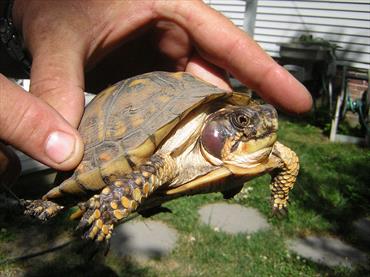Aural Hematoma - box turtle

Aural abscess in an Eastern box turtle. Photo by Dr. Suzanna Brown Vaino.
Ear abscesses, also known as aural abscesses, are common in turtles and tortoises and are usually caused by bacterial infections. The infection begins in the mouth and moves up into the ear canal through the eustachian tube, which is the ear’s opening into the mouth. Unlike mammals, turtles and tortoises do not have an open, external ear canal, so when an infection reaches the ear it has nowhere to go and builds up as a large pocket of pus. Pus in mammals, including humans, is liquid but as with all reptiles, in turtles and tortoises pus is firm with a cheesy consistency. Because of this firmness, the pus will not drain back into the mouth.
The pressure created in the closed ear from the growing abscess (an abscess is a localized collection of pus surrounded by inflamed tissue) may cause a break on the outside of the ear that is seen as a hole in the side of the head, or it may create a large swelling or lump on one or both sides of the head. If the abscess actually ruptures, the firmness of the pus keeps it inside the ear; if left untreated changes to the skull can occur, possibly resulting in permanent damage.
Ear abscesses can occur in turtles and tortoises when:
- their immune system is suppressed from stress such as during hibernation
- when they have a viral infection
- are in a poor environment (too wet or too dry)
- have just suffered a traumatic injury
- just been exposed to pesticides, or
- have a nutritional deficiency.
An ear abscess initially appears as a firm swelling behind the eye that may or may not continue to get bigger since it was first noticed. Your turtle's head may appear asymmetric, misshapen or not the same on both sides; however, it is possible for both ear canals to be affected at the same time so that the head does look the same on both sides. Based on the size of the abscess, you may have noticed a change in the turtle's behavior or in how it holds its head. It is often painful for the turtle to open its mouth, and this may cause your turtle or tortoise to stop eating as much or stop eating all together.
Many different types of turtles and tortoises get aural abscesses. North American box turtles are one common species that seem to get them a lot, and many of the water turtles like sliders get them. However, any species of turtle or tortoise can get them.
Diagnosis
The diagnosis of an aural abscess is made by a veterinarian after a thorough history and physical exam. It is often possible for your veterinarian to see pus protruding from the eustachian tube into the mouth; this is often diagnostic of an aural abscess. To understand conditions that may have predisposed your turtle to the infection and abscess, your veterinarian may ask questions about your turtle's living conditions, including water quality, humidity, temperature, and diet. It is not uncommon for turtles suffering from aural abscesses to have other illnesses at the same time, such as vitamin A deficiency.
Treatment
Surgery is required to remove the hardened pus from an aural abscess, but this is rarely life threatening. Surgery is the most effective and safest means of treating it. The surgery is a fairly rapid procedure that involves cutting under the abscess and pulling it out. Usually, very little bleeding occurs, and the ear canal is flushed to remove all pieces. The wound opening is left open and will heal on its own.
Depending on how bad the aural abscess is, your veterinarian may choose to give antibiotics before surgery. If this is the case, it is imperative that you follow the specific dosing instructions prescribed by your veterinarian.
During surgery to remove the infection, your veterinarian may take a swab of the ear canal to send to a laboratory for culture and sensitivity testing. This test will tell your veterinarian the specific types of bacteria that have populated your turtle's ear and the antibiotics to which the bacteria are most sensitive. This test enables your veterinarian to prescribe the most appropriate drugs for treatment of the infection.
Unfortunately, there is a chance that the abscess will recur, even with careful removal. Most turtles and tortoises go on to have an excellent quality of life.
Your veterinarian may ask for a medical recheck appointment after the surgery to make sure that the surgical site is healing appropriately. After your turtle or tortoise has recovered, continue to visit your veterinarian for routine health screenings and annual wellness visits.
Prevention
After diagnosis and treatment, it is important to follow any recommendations made by your veterinarian about diet changes or husbandry alterations because these may help prevent another abscess.
As discussed with your veterinarian, provide your turtle with appropriate temperature, humidity, and water quality. Water should be changed regularly, and frequent water bowl/terrarium disinfection is recommended. Consult your veterinarian or reliable husbandry resource about the proper diet for your turtle to ensure that you are feeding a nutritionally complete diet. A good husbandry resource can be found at Anapsid.
Follow the post-surgical dosing instructions for any medications prescribed by your veterinarian and make sure to complete the full course of medications; don’t stop giving the prescribed antibiotics just because the symptoms go away or because your turtle looks healthy.
Contact your veterinarian if the firm swelling returns and/or your turtle or tortoise starts to lose appetite, changes the way it holds its head, or you notice any whitish/yellow discharge from the surgical area.